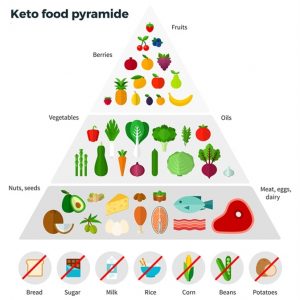Ketoacidosis is a dangerous and potential life-threatening metabolic complication of diabetes and other medical conditions, if it is not managed properly. Are you looking to learn more about this condition? Read on to gain an informed perspective into what ketoacidosis entails and how to spot it early. This article will provide invaluable advice, about what to look for and steps to take for those at risk.
Table of Contents
- 1. Understanding Ketoacidosis: The Risk and Reality
- 2. Exploring the Causes and Risk Factors of Ketoacidosis
- 3. Recognizing the Signs and Symptoms of Ketoacidosis
- 4. Managing and Treating Ketoacidosis
- 5. Tips for Prevention: What You Can Do to Avoid Ketoacidosis
- Q&A
1. Understanding Ketoacidosis: The Risk and Reality
One of the most frightening aspects of a ketogenic diet is the potential for developing ketoacidosis. But this risk is often over-exaggerated, leading to confusion and concern from many who are considering employing this type of nutrition plan. To better understand the true nature of ketoacidosis, let’s look at the basics.
To put it simply, ketoacidosis is a medical condition in which there is a build-up of ketones in the blood. This can be caused by a high carb diet, extreme fasting, illness, or consumption of too much alcohol. When this happens, the body can no longer use glucose for energy and must turn to fats and protein from food or stored body fat. The by-products of this process—ketones—accumulate in the blood, causing it to become acidic.
- Ketoacidosis is caused by a high level of ketones in the blood.
- It can be caused by an abundance of carbs, extreme fasting, or illness.
- Ketones are by-products that build up due to the body not being able to use glucose for energy.
While it can be alarming to consider, ketoacidosis is actually rare in individuals following a properly managed ketogenic diet. The risk is further minimized when paired with ample hydration and a diet that provides the necessary amount of essential vitamins and minerals.
- Ketoacidosis is only a risk when not managing a ketogenic diet properly.
- A balanced diet including required vitamins and minerals will reduce the risk.
- Hydration is also key in preventing ketoacidosis.
2. Exploring the Causes and Risk Factors of Ketoacidosis
Ketoacidosis is a complex condition, with multiple potential contributing factors. So, what are the main risk factors and causes of this life-threatening situation?
- Diabetes: The most common cause of ketoacidosis is diabetes. When blood sugar is left untreated for too long, the body begins to produce more ketone bodies than it can get rid of, leading to a dangerous accumulation.
- Alcohol Use: Drinking excessive amounts of alcohol can also lead to ketoacidosis, as the alcohol interferes with the pancreas’ ability to produce the correct amount of insulin.
- Kidney Disease or Failure: If the kidneys are not functioning correctly, they can’t clear ketones from the body, leading to ketoacidosis.
- Obesity: Carrying excess weight can lead to insulin resistance, which can in turn cause ketoacidosis.
- Infections: Infections and illnesses can also lead to ketoacidosis, as they can interfere with the way the body processes insulin.
Whatever the cause, it’s important to get help for ketoacidosis as soon as possible, as it can quickly become life-threatening. Regularly monitoring your blood sugar, and seeing a doctor regularly, is the best way to prevent it and catch it quickly if it does occur.
3. Recognizing the Signs and Symptoms of Ketoacidosis
Ketoacidosis is a potentially fatal medical condition caused by a severe lack of insulin in the body, usually in people with type 1 diabetes. It is important to identify the signs and symptoms of ketoacidosis as early as possible, to ensure that proper medical care is sought and to minimize the risk of long-term health consequences.
Signs and Symptoms to Look Out for Include:
- High blood glucose levels that cannot be lowered with insulin
- Nausea and vomiting
- Shortness of breath
- Extreme thirst
- Inability to think clearly
- Fruity-smelling breath due to ketones
Take the time to learn more about the symptoms of ketoacidosis, and recognize the signs early. Talk to your doctor if you have any concerns about the potential for ketoacidosis and how to prevent it. With the help of a specialized team of medical professionals, you can maintain a healthy and safe health condition.
4. Managing and Treating Ketoacidosis
Ketoacidosis can be an extremely dangerous medical condition, but with the right diagnosis and treatment plan, can be managed and effectively treated. The treatment plan should involve both lifestyle modifications and medications,.
- Lifestyle Modifications: This should include eliminating any foods or beverages containing large amounts of sugar or carbohydrates, as these can worsen the condition. Increasing physical activity is also beneficial, as it uses up excess glucose which can help improve the symptoms.
- Medications: The most common medications used in the treatment of ketoacidosis are insulin therapy, intravenous (IV) fluids and electrolytes, potassium, sodium, and calcium supplements, and other medications to help reduce inflammation.
It’s important to note that any treatment plan for ketoacidosis should be closely monitored by a healthcare professional to ensure that the condition is properly managed and the medications are being taken as prescribed.
5. Tips for Prevention: What You Can Do to Avoid Ketoacidosis
1. Know Your Risk Factors and Monitor Blood Sugars:
Ketoacidosis is most dangerous to those with type 1 or type 2 diabetes. Monitor blood sugar levels regularly or be sure to check with your healthcare professional. Be aware of your risk factors and take steps to lower them. These include obesity, an unhealthy diet, and inadequate blood sugar control.
2. Maintain Healthy Hygiene and Diet:
Adopting a healthy lifestyle is important in preventing ketoacidosis. Be sure to establish good hygiene habits like washing your hands before meals and after using the restroom. Also, make sure to follow a healthy diet that supports a healthy blood sugar level, with allowances for occasional treats. Eating regular meals that include complex carbs, lean proteins, and healthy fats is the best way to maintain a healthy blood sugar level.
Finally, talk to your healthcare provider about possible medications or therapies that are available to help relieve symptoms of ketoacidosis if it occurs. Be proactive and stay on top of your health in order to prevent the risks associated with ketoacidosis.
We hope this article informed you about the risks and causes of ketoacidosis. Remember, if you experience any of the symptoms mentioned, it’s best to contact your doctor as soon as possible for advice and treatment. Take care to stay on top of your health, and you will be sure to remain in the best condition possible.











